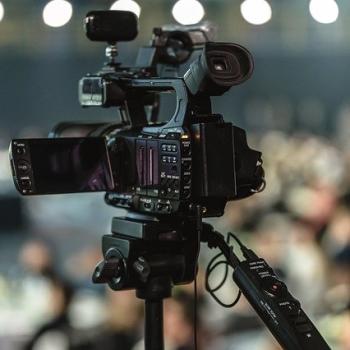
Abstract art, since its inception, has probably always been something of an acquired taste. For one thing, few such works truly speak for themselves—in propositional terms, that is—apart from some moniker, explanation, or contextualization. For another, it’s not obvious how exactly one is to assess the relative quality of a given piece: whereas representational art can be evaluated in terms of its verisimilitude, abstract works stand outside such a framework altogether.
These questions have provoked a number of reactions over the years. At one extreme are theologically-minded critics like Francis Schaeffer and H.R. Rookmaaker, who saw in the emergence of modern and contemporary art a full-scale repudiation of the traditional canons of beauty and meaning. At the other extreme are authors like Arthur Danto, who provocatively argued that the “end of art”—as traditionally understood—was in fact a necessary and historically inevitable event. For Danto and others sharing his sentiments, “art” as an evolving intellectual discipline effectively ended once the last stable rules of “art” faded away, leaving only theory and context in their place as determinants of meaning. In the present age, art is whatever we say it is.
That, at least, is the conviction held by James Figueras (Claes Bang), the art critic protagonist of Giuseppe Capotondi’s new film The Burnt Orange Heresy (newly available on streaming services). But fascinatingly, it is not a view that this provocative film appears to share.
(Spoilers below, but do note that this isn’t the sort of movie that depends on surprises in order to be worth seeing.)
We first meet Figueras at a fancy promotional event for his latest book, where the critic is expounding at length on a striking—if somewhat workmanlike—abstract piece. At first, Figueras dismisses the piece as flat and amateurish, and his audience obligingly nods along with him. But then, Figueras begins to explain the canvas’s backstory, spinning a tragic tale of sacrifice, lost love, and the horrors of the Holocaust…and immediately, the painting becomes interesting and compelling to Figueras’s listeners. But—twist upon twist!—this backstory is itself a lie, as Figueras helpfully informs his viewers after a long pause.
Figueras’s message couldn’t be clearer: artistic meaning and value are pure constructions—constructions, often, of critics like himself. There is no “inner truth” to a given painting or any standard against which its merit might be measured. Taken at face value, this would seem to be a vindication of Danto’s thesis: art is whatever we call art.
Figueras is soon after whisked away—along with female admirer Berenice (Elizabeth Debicki)—to the castle of an enigmatic old art collector (Mick Jagger) with a very specific curatorial request. Figueras—on pains of being outed as a scammer—is to go to the studio of notoriously reclusive artist Jerome Debney (Donald Sutherland)—whose only extant works were destroyed in a fire several years previously—and obtain one of the painter’s recent pieces, by whatever means necessary.
To Figueras’s horror, he soon learns that Debney hasn’t painted a single thing since the fire: the muse is well and truly gone. Determined not to return empty-handed, Figueras promptly elects to paint his own “Debney” canvas—the eponymous “burnt orange heresy”—only to be caught by Berenice partway through the project. Standing in their hotel room, her finger wet with paint from the fresh forgery, Berenice angrily confronts her corrupt lover…until he drowns her in a bathtub and rapidly stages the scene to resemble a suicide.
We last meet Figueras at the grand unveiling of the new “Debney” painting. The delighted collector lavishes praise on Figueras’s find, even remarking offhandedly about the “fingerprint” remaining on the canvas. In the instant of recognition that follows—in the moment Figueras realizes that the painting contains tangible physical evidence of the truth of Berenice’s demise—the film ends.
This revelation profoundly upsets Figueras’s own philosophy of art: Berenice’s fingerprint on the canvas inscribes into the work the cold, hard factuality of her murder. This is no longer something that can be dissolved into clouds of theory, criticism, or deconstruction; the truth of Figueras’s sin announces itself wholly apart from subjective interpretation. The “burnt orange heresy” means, among other things, that a fraud was committed and that a murder took place. And, the audience is left to ponder, cannot similar depths of meaning be found in other abstract works?
There is an echo here of what Jacques Derrida called the “trace”—the indefinite yet undeniable residuum of meaning that permits linguistic communication to occur, no matter how assiduously a critic or philosopher attempts to destabilize a text’s integrity. In the film’s closing minutes, Figueras is confronted directly with a very tangible “trace” that short-circuits his earlier swaggering nihilism. Perhaps, after all, there is something “undeconstructible” in any given artwork, and it is the search for that undeconstructible that accounts for the allure of art that so many people experience.
Derrida himself strenuously argued that this hat-tip to the possibility of undeconstructibility not be understood to have theological connotations, no matter how apophatic. I, however, do not share his biases against the transcendent: to admit the possibility of the undeconstructible—whether understood classically, as artistic beauty in general, or as in Figueras’s case, understood as starkly objective truth—is to admit the possibility of an absolute call on one’s intellect, will, and desires. And learning to live in right relationship to that call, in turn, strikes me as perhaps the most important task of life as a whole.












